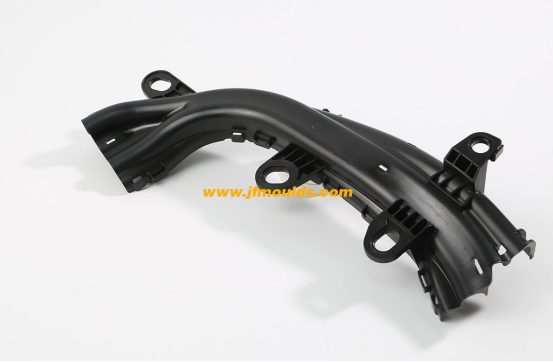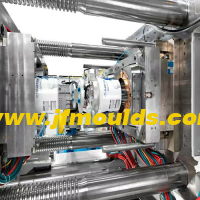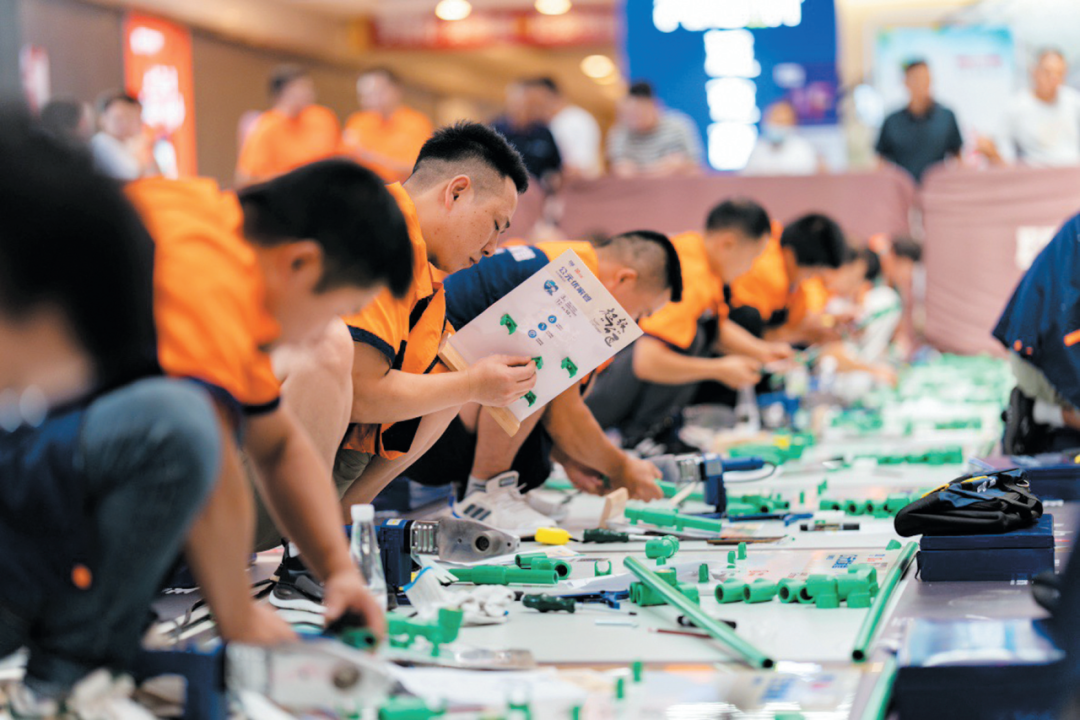From the basics to applications, how does it affect our lives
From the basics to applications, how does it affect our lives
The basic concepts and working principles of injection molds
Injection molds, known as the "mother of industry", are crucial process equipment in the plastic processing industry. It injects molten plastic raw materials into the mold cavity through an injection molding machine. After cooling and solidification, plastic products of the desired shape are obtained. From a micro perspective, a mold is like a precise "container" that determines the final form, dimensional accuracy and surface quality of plastic products.
Car bumper mold Manufacturer in China (jfmoulds.com)
The working principle of injection molds can be broken down into multiple orderly steps. First, pour the plastic particles into the hopper of the injection molding machine. Under the push of the screw, these particles gradually move forward. During the movement, the plastic particles are gradually melted by the heating device and transformed into a plastic fluid with good fluidity. At this point, the screw advances further, rapidly squeezing the plastic fluid into the mold cavity at high pressure until the entire cavity is filled. The cavity is the core part of the mold, and its shape is exactly the same as that of the plastic product. When the cavity is filled, the cooling circulation system on the mold starts to work, quickly removing heat and cooling and shaping the plastic fluid. Finally, the push rod of the injection molding machine presses against the bottom pin plate of the mold, and the ejector pin moves forward, smoothly pushing the formed plastic product out of the mold to complete one injection molding cycle. By repeating this cycle, large-scale production of plastic products can be achieved.
The structure and classification of injection molds
Analysis of Mold Structure
The structure of injection molds is complex and exquisite, mainly consisting of the core, blank (mold base), ejection system, cooling system, exhaust system and other auxiliary systems. The mold core, also known as the mold kernel, is the core component of the entire mold forming process. It directly determines the internal shape and size of plastic products, just like the "soul" of the mold. With the development of the mold industry, the mold base (mold base) has been standardized. In a set of molds, usually only the mold core part needs to be custom-processed, while other mold base components are mostly standard parts. This has greatly improved the efficiency and economy of mold manufacturing. The function of the ejection system is to smoothly push the plastic products out of the mold after they have cooled and formed, preventing the products from deforming or being damaged during the demolding process. It mainly includes ejector pins and the recovery system. The cooling system, also known as water transportation, plays a crucial role in maintaining the mold temperature and rapidly cooling the product. A reasonable design of the cooling system can effectively shorten the injection molding cycle and enhance production efficiency. The exhaust system is responsible for discharging the gases generated during the injection molding process to prevent the formation of defects such as pores and bubbles in the products, which could affect product quality. In addition, there are some auxiliary parts, such as support columns, ejection plates, guide columns, guide sleeves, garbage nails, etc. They work together to ensure the normal operation of the mold.
Detailed Explanation of Mold Classification
Injection molds can be classified into various types based on different standards. According to the structure of the mold, the common types are two-plate molds and three-plate molds. The two-plate mold, also known as the large sprue mold, has a relatively simple structure with only one parting surface. After injection molding, the runner and the plastic product are taken out from the same parting surface together. It is suitable for molding some plastic products with simple structures and large dimensions. The three-plate mold, also known as the fine sprue mold, has two parting surfaces. After injection molding, the runner compound and the plastic product can be taken out from different parting surfaces respectively. It is suitable for molding some plastic products with high appearance requirements and special requirements for gate positions. In addition, there is a hot runner mold, which keeps the plastic in the runner in a molten state through heating. During the injection molding process, no cold material is generated, thus saving raw materials and improving production efficiency. It is suitable for molding plastic products with high quality requirements and large production batches.
According to the molding process, they can be classified into thermoplastic injection molds and thermosetting plastic injection molds. Thermoplastic injection molds are used for molding thermoplastic plastics. These plastics soften and melt when heated and solidify upon cooling, and can be repeatedly heated and cooled. They have good plasticity and processing performance. Common plastic products such as polyethylene (PE), polypropylene (PP), and polyvinyl chloride (PVC) are all produced through thermoplastic injection molds. Thermosetting plastic injection molds are used for molding thermosetting plastics. These plastics undergo chemical reactions under heating and pressurization conditions, transforming from linear structures to three-dimensional ones. Once molded, they will not soften or melt even when heated again, such as phenolic plastics and amino plastics. They are often used to manufacture some electrical insulation components and mechanical parts.

Automobile parts mold Manufacturer in China (jfmoulds.com)
The manufacturing process and technological development of injection molds
Evolution of manufacturing processes
The manufacturing process of injection molds has undergone an evolution from traditional processing methods to modern advanced manufacturing technologies. In the early days, mold manufacturing mainly relied on conventional processing methods such as sawing, planing, broaching, broaching, milling, turning, drilling, reaming, boring, 锪, boring, grinding and honing. Although these methods can meet certain processing accuracy requirements, their production efficiency is relatively low and they are difficult to process molds with complex shapes. With the development of technology, special processing technologies have emerged, such as electrical discharge forming, electrical discharge wire cutting, electrolytic forming, electrolytic polishing, electrolytic grinding and regrinding, and photoetching, etc. Electrical discharge forming utilizes the thermal energy generated by discharge to erode metal materials, capable of processing complex-shaped mold cavities with high processing accuracy. Electrical discharge wire cutting (EDM) processing uses fine metal wires as electrodes and generates high temperatures through discharge to melt metal materials. It is suitable for processing precision parts and complex shapes of molds and has the advantages of high processing accuracy and small processing deformation.
The emergence of numerical control machining technology has brought revolutionary changes to the manufacturing of injection molds. Numerical control machining achieves high-precision and high-efficiency processing by programming and controlling machine tools, and can realize the automated production of complex molds. Meanwhile, surface technologies of molds have also been widely applied, such as surface strengthening technology, surface decorative processing, and finishing processing technology, etc. These technologies can enhance the hardness, wear resistance, corrosion resistance and surface quality of the mold surface, and extend the service life of the mold. In addition, mold-making methods such as cold extrusion, low-pressure casting, and precision casting, as well as rapid mold-making technologies like those based on rapid prototyping (RP), are constantly evolving and improving, providing more options and possibilities for the manufacturing of injection molds.
Trends in cutting-edge technologies
At present, injection mold technology is developing in the directions of intelligence, lightweighting, precision and greenness. In terms of intelligence, technologies such as artificial intelligence (AI), big data, and the Internet of Things (IoT) are gradually being applied to the design, manufacturing, and production process monitoring of injection molds. For instance, the AI parameter optimization system can adjust the temperature, pressure and other parameters of the injection molding machine in real time, and intelligently optimize them based on the real-time production situation of the products, thereby improving product quality and reducing the rate of defective products. Through Internet of Things (iot) technology, mold manufacturing enterprises can achieve remote monitoring and management of the mold production process, promptly identify and solve problems in production, and enhance production efficiency and management levels.
Lightweighting is another important trend in the development of injection mold technology. As global demands for energy conservation and emission reduction continue to rise, all industries are pursuing lightweight design of their products. In the field of injection molds, by adopting new materials and optimizing the mold structure design to achieve lightweight molds, not only can the manufacturing cost and energy consumption of molds be reduced, but also the production efficiency and service life of molds can be improved. For instance, by using new materials such as carbon fiber reinforced composite materials to manufacture mold components, the weight of the mold is effectively reduced while ensuring its strength and rigidity.
Precision is also an inevitable trend in the development of injection mold technology. With the continuous improvement of the precision requirements for plastic products in industries such as electronics and medical care, injection molds need to have higher processing accuracy and dimensional stability. Advanced processing equipment and techniques, such as high-precision CNC machine tools, micro-electrical discharge machining, and laser engraving, are constantly being applied in injection mold manufacturing, enabling the processing accuracy of molds to reach the micrometer or even nanometer level, meeting the production demands of high-end products.
Greening is a new direction for the development of injection mold technology. Today, with the increasing environmental awareness, injection mold manufacturing enterprises are paying more and more attention to the application of green manufacturing concepts. Measures such as adopting recyclable materials, optimizing production processes to reduce waste emissions, and lowering energy consumption have become important ways for injection mold manufacturing enterprises to achieve sustainable development. For instance, some enterprises use biodegradable plastics as mold manufacturing materials. After the service life of the molds comes to an end, they can naturally degrade, reducing pollution to the environment.
Challenges Faced by Injection Molds and Countermeasures
Challenge Analysis
Although injection mold technology has made considerable progress, it still faces many challenges in practical applications. First of all, the high cost of molds is a prominent issue. Before mass production, molds need to be designed, manufactured and tested, a process that requires a significant investment of human, material and time resources. Moreover, to ensure that the mold produces parts with accurate dimensions, multiple iterations and trial runs are often required, which further increases the development cost of the mold. For some small enterprises, the high cost of molds may become a bottleneck for their development.
Secondly, the difficulty in changing the design of parts is also a problem faced by injection molds. Once the mold is made, it becomes very difficult to change the shape and size of the parts, which to some extent restricts the innovation and upgrading of the products. In today's rapidly changing market demand, enterprises need to be able to respond quickly to market demands and make flexible adjustments and improvements to their products. However, this characteristic of molds has brought considerable troubles to enterprises.
In addition, various quality problems may occur during the production process of injection molds, such as dimensional deviations of injection molded parts, surface defects (such as weld marks, pores, flash, etc.), deformation, etc. These quality issues not only affect the appearance and performance of the products, but may also lead to product scrapping and increase production costs. Meanwhile, as plastic products are increasingly widely used in various fields, the requirements for their quality and performance are also getting higher and higher, which poses higher challenges to the manufacturing and production of injection molds.
Discussion on Coping Strategies
In response to the problem of high mold costs, enterprises can take various measures to deal with it. On the one hand, by optimizing mold design, adopting standardized mold bases and components, the workload of customized design and processing can be reduced, thereby lowering the design and manufacturing costs of molds. On the other hand, strengthening the management and control of the mold manufacturing process, enhancing production efficiency, and shortening the mold development cycle can also effectively reduce costs. In addition, enterprises can also establish long-term cooperative relationships with suppliers to strive for more favorable purchase prices and reduce raw material costs.
To address the difficulty in changing part designs, enterprises can introduce digital design and manufacturing technologies, such as Computer-aided Design (CAD), Computer-aided engineering (CAE), and computer-aided Manufacturing (CAM), etc. Through these technologies, enterprises can design, analyze and optimize products and molds in a virtual environment, identify problems in the design in advance, and make modifications and adjustments to avoid costly changes after the mold manufacturing is completed. At the same time, the adoption of rapid mold-making technologies, such as 3D printing technology, can also quickly respond to changes in part design and reduce change costs.
For the quality problems in the injection mold production process, enterprises need to establish a complete quality control system. From the procurement of raw materials, the design and manufacture of molds, the adjustment of injection molding processes to the inspection and acceptance of products, strict quality control must be carried out at each link. For instance, in the raw material procurement stage, suppliers with stable quality and reliable performance should be selected, and strict inspections should be conducted on the raw materials. In the mold design and manufacturing process, advanced design software and processing equipment are adopted to ensure the precision and quality of the molds. In the injection molding process adjustment stage, through experiments and data analysis, the optimal injection molding process parameters are determined, and the changes in process parameters during the production process are monitored in real time, with timely adjustments made. In the product inspection and acceptance stage, high-precision inspection equipment and strict inspection standards are adopted to conduct a comprehensive inspection of the products to ensure that their quality meets the requirements. In addition, enterprises can also enhance the training and management of their employees, improve their quality awareness and operational skills, and fundamentally ensure product quality.
Related News
Injection mold industry: Breaking through technological barriers and seizing the new track of intelligent manufacturing
2025-07-01
Injection mold industry: Breaking through technological barriers and seizing the...
Exhaust the breathable steel of the mold
2025-10-17
Exhaust the breathable steel of the mold Permeable steel is a sintered allo...
Design of Injection mold gating system
2025-10-20
Design of Injection mold gating system The injection system of an injection...
Panoramic Insight into the Injection Mold Industry: Forging Ahead in the Wave of Change
2025-07-04
Panoramic Insight into the Injection Mold Industry: Forging Ahead in the Wave of...
Solutions for mold clamping lines, surface clamping marks and clamping position sticking to the mold
2025-08-15
Solutions for mold clamping lines, surface clamping marks and clamping position ...
Huangyan: Building a
2025-06-22
Huangyan District of Taizhou City is known as the "hometown of moulds in China"....





